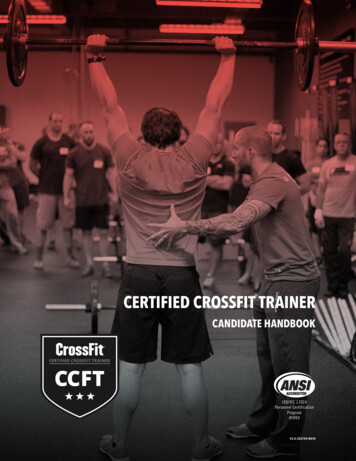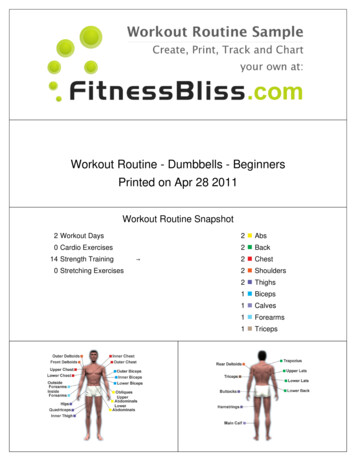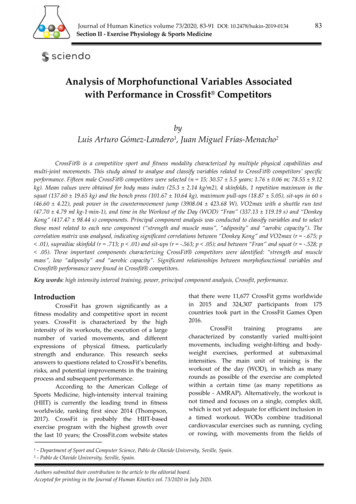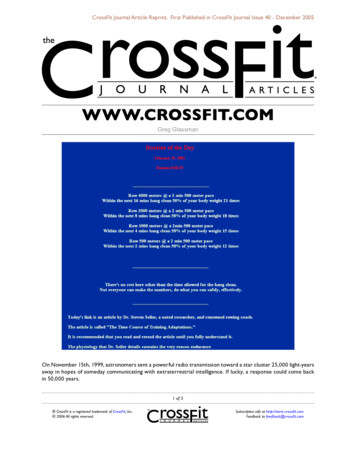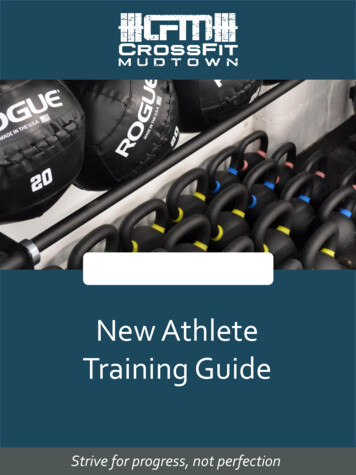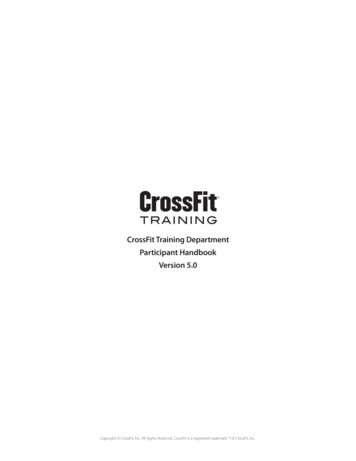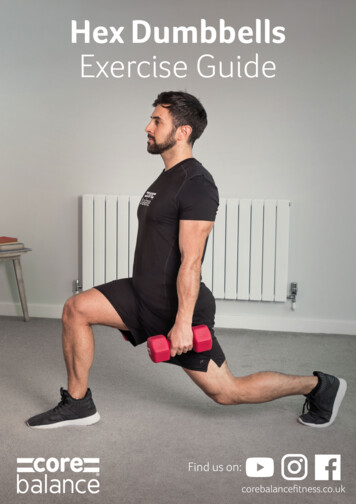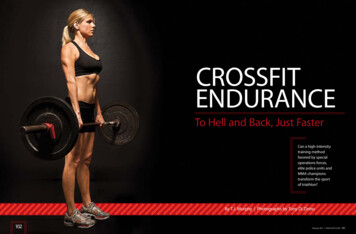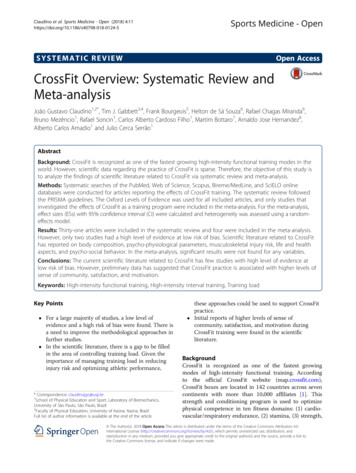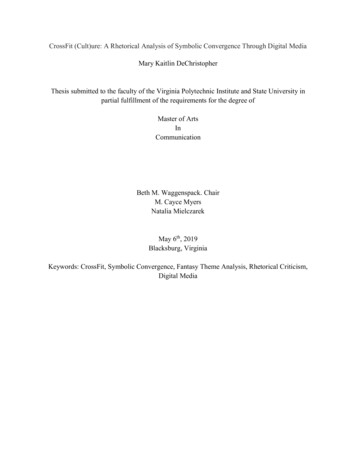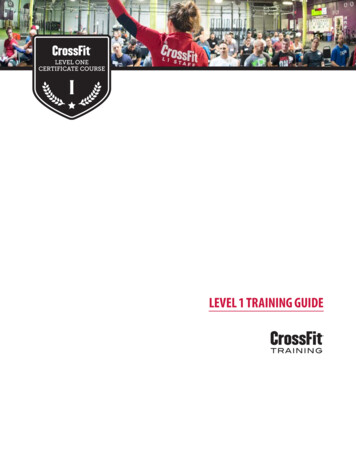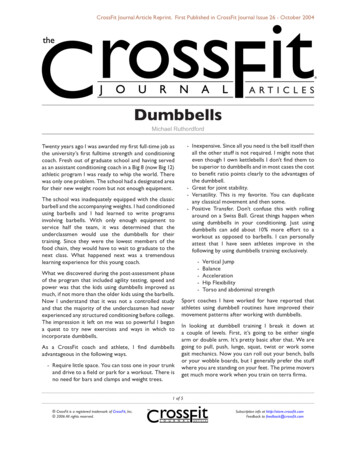
Transcription
CrossFit Journal Article Reprint. First Published in CrossFit Journal Issue 26 - October 2004DumbbellsMichael Ruthordford- Inexpensive. Since all you need is the bell itself thenall the other stuff is not required. I might note thateven though I own kettlebells I don’t find them tobe superior to dumbbells and in most cases the costto benefit ratio points clearly to the advantages ofthe dumbbell.- Great for joint stability.- Versatility. This is my favorite. You can duplicateany classical movement and then some.- Positive Transfer. Don’t confuse this with rollingaround on a Swiss Ball. Great things happen whenusing dumbbells in your conditioning. Just usingdumbbells can add about 10% more effort to aworkout as opposed to barbells. I can personallyattest that I have seen athletes improve in thefollowing by using dumbbells training exclusively.Twenty years ago I was awarded my first full-time job asthe university’s first fulltime strength and conditioningcoach. Fresh out of graduate school and having servedas an assistant conditioning coach in a Big 8 (now Big 12)athletic program I was ready to whip the world. Therewas only one problem. The school had a designated areafor their new weight room but not enough equipment.The school was inadequately equipped with the classicbarbell and the accompanying weights. I had conditionedusing barbells and I had learned to write programsinvolving barbells. With only enough equipment toservice half the team, it was determined that theunderclassmen would use the dumbbells for theirtraining. Since they were the lowest members of thefood chain, they would have to wait to graduate to thenext class. What happened next was a tremendouslearning experience for this young coach.What we discovered during the post-assessment phaseof the program that included agility testing, speed andpower was that the kids using dumbbells improved asmuch, if not more than the older kids using the barbells.Now I understand that it was not a controlled studyand that the majority of the underclassmen had neverexperienced any structured conditioning before college.The impression it left on me was so powerful I begana quest to try new exercises and ways in which toincorporate dumbbells.As a CrossFit coach and athlete, I find dumbbellsadvantageous in the following ways.- Require little space. You can toss one in your trunkand drive to a field or park for a workout. There isno need for bars and clamps and weight trees.-Vertical JumpBalanceAccelerationHip FlexibilityTorso and abdominal strengthSport coaches I have worked for have reported thatathletes using dumbbell routines have improved theirmovement patterns after working with dumbbells.In looking at dumbbell training I break it down ata couple of levels. First, it’s going to be either singlearm or double arm. It’s pretty basic after that. We aregoing to pull, push, lunge, squat, twist or work somegait mechanics. Now you can roll out your bench, ballsor your wobble boards, but I generally prefer the stuffwhere you are standing on your feet. The prime moversget much more work when you train on terra firma. of 5 CrossFit is a registered trademark of CrossFit, Inc. 2006 All rights reserved.Subscription info at http://store.crossfit.comFeedback to feedback@crossfit.com
Dumbbells (continued.)We will start with some basics and moveto some more complex movements.LUNGINGSPRINT TECHNIQUE LUNGE WALKI really like double-arm weighted lungewalking and single-arm weight lunge walks.This is a fundamental movement patternthat is not used enough. At CrossFitKansas City we lunge walk every day aspart of our warm-up. When the mood isright we use dumbbells for the walk. Pullup the toe, tighten the glute and strideunder control. The torso is erect withhands moving from the hip to the lip. Westride forward and backward.I also like the HAMMER technique with thebell in front and at the side. The balanceand stabilization here is outstandingFinally, we use OVERHEAD lunges as part of our programming. Ihave noticed the dumbbell overhead lunge has been showing up at lotat universities and colleges across the country. This is an outstandingmovement.CrossFit coaches should, at the least use some of these lungemovements in their warm-ups. of 5 CrossFit is a registered trademark of CrossFit, Inc. 2006 All rights reserved.Subscription info at http://store.crossfit.comFeedback to feedback@crossfit.com
Dumbbells (continued.)OVERHEAD SQUATSAnyone who wants to maximize his or her abilities needs to overhead squat.With a single dumbbell in your hand this is a completely different experience.CLEANS & PUSH PRESS/PUSH JERKSI have observed that learning the shrug part of the pull with a dumbbell can beeasier than learning with a bar. The athlete is more able to feel what that shrug doesto the dumbbell than when holding both hands on the bar. I generally recommendthat you alternate arms initially. Once you have the feel for the movement thenproceed to the double-arm movement. Unlike the barbell version you will nothave to unlock your grip to have the barbell in the proper rack position. You willbe holding the bells hammer style. The biggest issue I see with cleaning a dumbbellis the inexperienced athlete turning it into a hammer curl. Strike yourself 12 timeswith PVC whenever you do this.The push press/push jerks from here arestraight up from the shoulders past theears and really feel powerful! Concentrateon slapping the floor with your foot withthe split jerk.Obviously you put them together pullingfrom the hang, the floor or a combinationof hang, push press; floor push jerk couldbe one of your complexes. Are you havingfun yet? of 5 CrossFit is a registered trademark of CrossFit, Inc. 2006 All rights reserved.Subscription info at http://store.crossfit.comFeedback to feedback@crossfit.com
Dumbbells (continued.)SNATCH VARIATIONSThese are clearly my favorites. The snatch is oneof the fastest movements in athletics. With adumbbell in your hand it really gets smoking.The muscle snatch is a good warm-up and teachingtool. Stand in front of a wall to feel how you needto bring the load up close to the body.Once you have this down then move to singlearm snatch. You can start from the hang or fromthe floor. Remember that the longer your pull themore work you are doing. Pulling from the floor ismy preference and recommendation.The single-arm, single-leg dumbbell snatch withsplit catch is a movement I learned from TomCross at Mid-American Nazarene University. Thisis a highly athletic movement. From the hang withone bell in your right hand you balance on yourleft leg. In one explosive movement you snatchthe bell and drop into a split stance with the rightfoot forward.OTHER APPLICATIONSYou can challenge your athleticism with dropsnatch, duck walk and press at the bottom. I liketo call it the PIG ON ICE SKATES. I named itthis after watching some 300lb offensive linemanwarm-up with a version of this movement. Afterperforming a drop snatch with one or two dumbbellstake 4 steps forward, 4 backward, 4 left then 4 right andfinish with a press to stand. of 5 CrossFit is a registered trademark of CrossFit, Inc. 2006 All rights reserved.Subscription info at http://store.crossfit.comFeedback to feedback@crossfit.com
Dumbbells (continued.)CrossFit athletes can become very frustrated withthe handstand push-up (HSPU). My athletes like thechallenge of the squat dumbbell press as a substitutefor the HSPU. This takes out the knee kick and corebut adds additional challenge and uniqueness to theworkout.A COMPLEX TO CONSIDERI have located a number of tremendous complexmovements to use over the years. My rules are simple.Never use more movements than are allowed by shortterm memory and secondly more than you can devote100% of your energy towards.With these rules in mind, I typically compose complexdrills with two to four exercises. Some related andsome unrelated.One of our more infamous complex movements at ourfacility involves a single dumbbell and three movements.Four snatches right, four snatches left followed by 4overhead squats right, 4 overhead squats left. We thenfinish with alternating lunges 4 left , 4 right while holdingthe dumbbell in the right hand and then in the left.What we discovered during the postassessment phase of the programthat included agility testing, speedand power was that the kids usingdumbbells improved as much, if notmore than the older kids using thebarbells.This was not to be presented as the definitive articleon how to use dumbbells. My hope is that you willview these as another quality tool in your toolbox ofmovements. If you are planning the trek to Coloradoin November we will be spending some time exploringthese movements and others in detail. Until then, trysome CrossFit workouts of the day with dumbbells. Youwon’t be disappointed.Michael Rutherford (a.k.a. Coach Rut) is theowner of CrossFit Kansas City/Boot CampFitness. He has over a quarter-century offitness coaching experience with athletes of allages. He has also worked in hospital wellnessenvironments and rehabilitation clinics. CoachRut holds academic degrees in biology, physicaleducation, and exercise physiology and sportsbiomechanics. He is a USAW-certified ClubCoach and is a CrossFit level 3 trainer. He isalso the current national Masters Championin weightlifting at 94 kg. You can learn moredumbbell exercises from his DVDs DumbbellMoves Volume 1 and Volume 2. of 5 CrossFit is a registered trademark of CrossFit, Inc. 2006 All rights reserved.Subscription info at http://store.crossfit.comFeedback to feedback@crossfit.com
athletes using dumbbell routines have improved their movement patterns after working with dumbbells. In looking at dumbbell training I break it down at a couple of levels. First, it's going to be either single arm or double arm. It's pretty basic after that. We are going to pull, push, lunge, squat, twist or work some gait mechanics.
